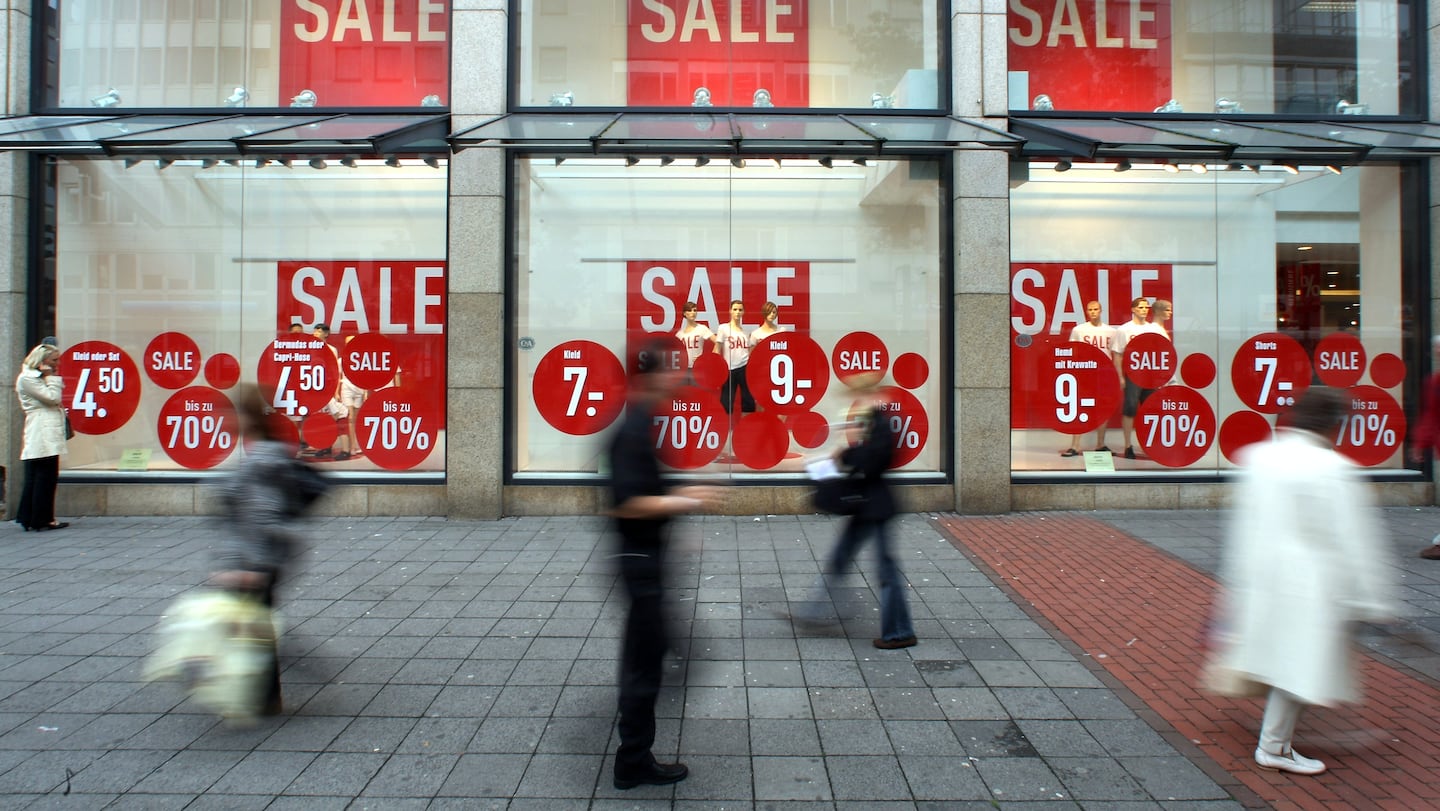
The Business of Fashion
Agenda-setting intelligence, analysis and advice for the global fashion community.

Agenda-setting intelligence, analysis and advice for the global fashion community.

COPENHAGEN, Denmark — You know the fashion industry has an inventory problem when even Danish “it” label Ganni is scrambling to offload piles of unsold clothes.
The brand's clothes and accessories normally fly off the shelves at luxury department stores, whose customers see a $400 Ganni dress as the key to completing their accessible yet Instagram-ready look. But most of Ganni's best stockists closed in March, and online shopping hasn't made up the gap, so the label is sitting on extra leopard print wrap dresses and light neon sweaters that are rapidly falling out of season.
Ganni is sending some of that merchandise to online outlet The Outnet and luxury resale site The RealReal. It's planning an online "archive" sale at the end of April that will see some out-of-season items marked down by as much as 70 percent for five days. A new website, modeled on the brand's concept store in Copenhagen that sells past seasons' collections at a discount, is in the works. And finally, some clothes will be "upcycled" into new garments.
“Typically, we are the bread and butter of our average wholesale customer’s store,” said Founder Nicolaj Reffstrup, explaining that the brand has seen no order cancellations, which are plaguing smaller brands. “But having said that, of course, we have a massive inventory problem that we are trying to deal with.”
ADVERTISEMENT

Ganni is gearing up to offer an online sale of past season items at the end of April | Source: Courtesy
Ganni's inventory woes are shared by just about every fashion brand and retailer. Brands always factor discounts into their business models — they only need a portion of inventory to sell at full-price to turn a profit — but the coronavirus store closures have escalated the problem exponentially. Many brands have mountains of unsold clothes so big that they are running out of places to store it. With economists predicting a sharp downturn in consumer spending, and department stores already cutting back on orders for the summer and autumn, the overstock problem is only going to get worse.
Excess inventory is more than a space issue. Each unsold shirt or bag represents money spent on production and marketing that hasn’t been recouped (and renting a warehouse just to store unwanted clothing is expensive too).
Many brands desperately need that money to pay employees and suppliers now. But getting rid of inventory is harder than ever: off-price stores like T.J. Maxx are closed until lockdowns lift. Burning clothes, once routine at some luxury labels, has become riskier after Burberry faced a consumer backlash for the practice in 2018 and France banned it in 2019.
The remaining options: offer flash sales on new items now, wait for off-price stores to reopen (or work with their online equivalents), hold out-of-season sales, or, as a last resort, throw the unwanted clothes away. The goal is to extract as much cash as possible while minimising damage to the brand.
“Whatever ability [brands] have to liquidate it, they need to liquidate it,” said Gary Wassner, an investor and founder of Hilldun, a factoring firm that provides designers with credit, about spring and summer inventory. “They need to accept the losses.”
Sell It
Rixo, a London-based label known for its vintage-inspired patterned dresses, found itself stuck with 50 percent more inventory than expected after retailers cancelled spring and summer orders. Last week, the brand offered customers 30 percent off new pieces online, the first time it ever marked down new merchandise. The response was so strong that Rixo’s website crashed in the first hours of the sale.
ADVERTISEMENT
Rixo wants its sale to be a one-time event. The brand hopes to open a pop-up shop in Australia this autumn, betting that loyal customers there will want to pay full price when they see the clothes in person when the weather warms there.
“Everything we do with Rixo is all about longevity and not about a quick win with two seasons, that doesn’t get you anywhere,” said Henrietta Rix, who co-founded and self-funded Rixo with Orlagh McCloskey in 2015.
Luxury labels are rebranding off-price promotions as "archive sales," with Alexander Wang and Proenza Schouler among those offering older merchandise at deep discounts. Rosie Assoulin is putting one item on sale each week.

Rixo's sale crashed its website on April 15 | Source: Courtesy
"There will be the biggest markdown season ever, and many brands will suffer a lot," said Mario Ortelli, managing partner of luxury advisors Ortelli & Co, who advises brands to try to delay markdowns whenever possible.
But discounting can be a tough habit to break, especially when the entire industry is relying on markdowns to move excess stock. Spring merchandise is already discounted by around 30 percent at online luxury retailers like MatchesFashion and Moda Operandi, while Nordstrom is marking down some items by 60 percent.
Shift It
Some brands are looking for new ways to move products with their usual wholesale partners shut down.
ADVERTISEMENT
German online retailer Zalando is expanding its concession platform during the crisis, signing on brands to sell products through the site. The sellers hold the inventory but can ship through Zalando's network.
Some European and American boutiques that were forced to close are selling their inventory on Farfetch, which reported better than expected preliminary first-quarter results last week. The marketplace said sales in China in February and March grew faster than they did in the same period in 2019.
"[We are] on the phone every day with boutiques and telling them there is demand for luxury and very strong in China and other countries in [Asia]," Chief Executive José Neves told BoF.
While the off-price channel is hurting with thousands of stores closed, particularly in North America where it exists mostly off-line, it will likely come roaring back when the lockdowns are lifted.
Some major off-price retailers, like the brick-and-mortar dependent T.J. Maxx, are reportedly not taking new stock right now, as they have plenty of inventory already and nowhere to sell it.
Smaller off-price retailers in places where life has begun returning to normal, like Asia and parts of Europe, are buying but tend to only want highly sought after brands and deep discounts, said Ronen Lazar, chief executive and co-founder of Inturn, a software platform that helps apparel companies connect with off-price buyers.
“There is so much inventory and it is from every brand under the sun,” he said. To stand out with off-price buyers, Lazar recommends bringing available merchandise to life with “rich visuals that allow you to position your brand and your product in the optimal light, as opposed to just sending spreadsheets.”
There is so much inventory and it is from every brand under the sun.
As with sales on their own sites, brands risk becoming associated with year-round discounting if consumers see too much of their inventory on discount racks or off-price websites.
Trash It
Fashion’s waste problem is nothing new: brands always produce more items than they can sell each season, because it is cheaper to destroy the leftovers than produce less to begin with. Between 10,000 and 20,000 tonnes of textile products are destroyed every year in France, according to a government report when it banned burning in 2019. But as burning and trashing extra products becomes more of public-relations liability, more brands are finding alternatives, like donating to NGO’s and charities like Smart Works in the UK.
"Upcycling" is becoming more popular, too, as more brands invest in sustainable production to appeal to conscious shoppers. More brands are likely to incorporate this year's unsold clothes into future collections. Many independent designers have made using deadstock materials (or leftover fabric, unsold clothes and vintage textiles) a sustainable, trendy approach in recent years.
At Ganni, upcycled capsules have previously served more as marketing opportunities to showcase the brand’s environmental values, but Reffstrup, the CEO, wants these garments to become a more consistent and commercial part of the business.
But upcycling requires more work than a normal garment, cutting into profits. “We need to tweak and figure out how to make decent money off of this,” he said.
Brands can also collaborate with designers and artists, many of whom are out of work right now, to give old inventory new life through screenprinting and embroidery, said Céline Semaan-Vernon, founder of sustainable fashion agency The Slow Factory.
Keep It
Brands can always roll the dice and try to sell their spring and summer collections next year, assuming they can afford to store it in the meantime. That strategy makes the most sense with brands that sell basics and other timeless items; a trendy piece won’t age as well.
Ultimately, the best strategy may be to assume a heavy loss on inventory currently sitting in warehouses, and plan to produce less in the future to avoid a repeat.
Some brands are skipping the upcoming resort season, or relocating their pre-autumn deliveries to hit stores in October and November instead.
Ganni plans to create smaller, more frequent collections moving forward, Reffstrup said, which will keep online channels supplied with new products that stand a better chance of selling at full price because of limited availability.
Rixo also produced a “very tiny” pre-autumn and autumn collection to minimise the risk of needing to hold more sales.
Other brands are shifting their aesthetic to a more classic look that will wear well over multiple seasons.
“What is going to make the consumer happy when they return to the market? It’s going to be a different product mix,” Wassner said. “It’s going to be a different consumer.”
Additional reporting by Sarah Kent.
We’re tracking the latest on the coronavirus outbreak and its impact on the global fashion business. Visit our live blog for everything you need to know.
 Opens in new window
Opens in new windowRelated Articles:
[ Is This the End of Wholesale, or the Beginning of Something Better?Opens in new window ]
[ How to Discount Smartly During Covid-19Opens in new window ]
[ Rental and Resale Were Supposed to Be the Future. Could Coronavirus Change That?Opens in new window ]
As the German sportswear giant taps surging demand for its Samba and Gazelle sneakers, it’s also taking steps to spread its bets ahead of peak interest.
A profitable, multi-trillion dollar fashion industry populated with brands that generate minimal economic and environmental waste is within our reach, argues Lawrence Lenihan.
RFID technology has made self-checkout far more efficient than traditional scanning kiosks at retailers like Zara and Uniqlo, but the industry at large hesitates to fully embrace the innovation over concerns of theft and customer engagement.
The company has continued to struggle with growing “at scale” and issued a warning in February that revenue may not start increasing again until the fourth quarter.